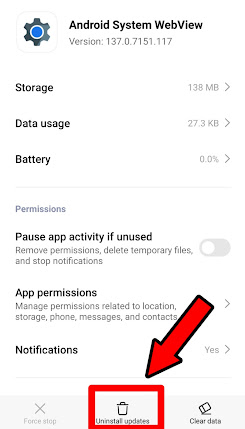Android System WebView: Should You Disable It
or Not? (Guide)
If you've ever
scrolled through your Android phone’s app list, you may have come across an app
called Android System WebView. You didn’t install it, but it takes up storage
space and receives regular updates. So what is it? And should you disable it?
In the complete guide,
we’ll answer every question you may have about Android System WebView from what it does to whether it’s safe (or
wise) to disable it.
What is the Android System WebView?
Android System WebView is a built-in system component powered by Chrome that allows Android apps to display web content within the app without opening an external browser.
For example:
When you click on a
web link in Facebook, Instagram, or WhatsApp, it opens inside the app itself.
That’s Android System WebView at the work.
It acts like:
A mini browser for the
apps
A rendering engine
that shows web pages inside the apps
A bridge between app
UI and online content
Why Is Android System WebView Important?
Here’s why Android System WebView is crucial:
Saves time: You don't
need to leave an app to open a link in Chrome.
Improves performance:
Web content loads faster inside apps.
Secures browsing:
Isolated from main browser, so risky content doesn’t infect Chrome.
Reduces app size:
Developers don’t need to add browsers in each app.
Can You Disable Android System WebView?
Yes but only in
certain Android versions. Whether or not you can (or should) disable it depends
on your Android version and system setup.
Android 10 and Below:
You should NOT disable
it.
Android 11 and Above:
On some newer devices, WebView’s role is taken over by Chrome, so Android System WebView may be disabled by default.
Should You Disable Android System WebView?
In most cases, NO, you
should NOT disable it.
Here’s why:
Reason Explanation
Breaks App
Functionality Some apps like Gmail, Facebook, and Instagram depend on it to
open links. Disabling it may cause links to crash or not open at all.
Security Risks WebView
updates include security patches. Disabling or uninstalling it could expose
your phone to online threats.
System Dependency Many
apps are hard-coded to use WebView. Removing it may cause system instability.
When Can You Disable WebView?
There are the only a
few cases where it is okay to disable:
1. You are on Android
11+ AND
2. Google Chrome is
enabled AND
3. You're facing a bug
or WebView conflict AND
4. You’re aware of
what you’re doing
Warning: Disabling WebView to "save space" or "improve
speed" is a myth. It may lead to more problems than benefits.
How to Disable Android System WebView (If
Needed)
If you meet the
criteria and still want to try disabling it:
Steps:
1. Go to Settings >
Apps > See all apps
2. Scroll to Android
System WebView
3. Tap Disable
On newer phones, you
may not see the option to disable. In that case, Chrome is likely handling
WebView duties.
Common Issues Caused by Disabling WebView
Here are the most
reported problems after disabling WebView:
App crashes when
opening a link
Gmail shows a blank
screen for emails
In-app browsers stop
working
Blank content in Facebook/Reddit
News apps won’t load
articles
If you're experiencing
these issues, re-enable or update WebView immediately.
How to Re-Enable or Update WebView
To re-enable:
1. Go to Settings >
Apps > Android System WebView
2. Tap the Enable
To the update:
1. Open the Google
Play Store
2. Search Android
System WebView
3. Tap Update
Keeping it updated is
essential for both security and app performance.
Myths About Android System WebView
Let’s bust some
popular myths:
Myth Truth
"Disabling
WebView boosts performance." False. It may crash apps and cause
instability.
"It’s
spyware." False. It’s a Google system tool, not spyware.
"I don’t use
it." You may not realize it, but dozens of apps rely on it.
"It can be safely
uninstalled." It’s a core Android component — uninstalling is not
recommended.
WebView vs Chrome: What’s the Difference?
Chrome is a full
browser.
WebView is a
background tool apps use to open web content.
On Android 11+, Chrome
can act as the WebView provider.
But you still need one
of them enabled to avoid issues.
Pro Tip for Developers
If you're a developer,
you can choose a custom WebView renderer by enabling Developer Options >
WebView Implementation and selecting your preferred option (like Chrome Beta or
WebView Dev).
Best Practices for Users
Don’t disable system
apps unless you know their purpose.
Always keep Android
System WebView updated via the Play Store.
If you’re experiencing
app crashes, check if WebView needs an update.
Use Chrome or another
browser as fallback for web-heavy apps.
Final Verdict
Should You Disable Android System WebView?
In 99% of cases NO.
It’s essential for smooth app performance and web content rendering inside
apps.
Only disable it if:
You’re on Android 11+
Chrome is fully
updated and enabled
You’re debugging a
specific issue
Otherwise, leave it on
and updated.
Android system webview
Disable android system
webview
Android webview
Android app
performance
Android tips and
tricks
Mobile performance
optimization
System webview guide
Android settings
explained
What is android
webview
Should I disable
webview









![[FIX] Android Notifications Not Showing on Lock Screen – Simple Solutions!](https://blogger.googleusercontent.com/img/b/R29vZ2xl/AVvXsEhOhpcykkGYV5uE_Z3UW70qNMJg2BOiSCJy-5MrTFFI5ArIjJQUInoxA9N0d1dzRSN2eJ1xvAWGOGnSPzLRm8h7xyB8iRnGDCS3XnyTioEKKHJB1-BAFEN79gr61NeZouRmreZcgVsaudX3rr0htL3tLubwFIVpa1j8uovo0Osa8wwQEyLrl4mgvdS5/w72-h72-p-k-no-nu/20250725_164531.jpg)

![Android System Webview: Should You Disable It or Not? [Expert Guide]](https://blogger.googleusercontent.com/img/b/R29vZ2xl/AVvXsEhrzJXlYA2vTLKJNzlBnvOZW4eEwGIF-2ex3NAtX593Y3VEG_dj0sRHkhgZ_O3IDYKECdurrs9UfymMIidEiBIPhdeBjkcoZlg0gbvcTk9PvY1FNcgniAaZBR7iE5tEiYkW7KDf0RP0k_8AuTswbHnpT0yglOuisdGbs6Iu6MEdAX5wcU8XasITjHvm/w72-h72-p-k-no-nu/1752122021838.jpg)

0 Comments